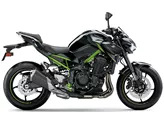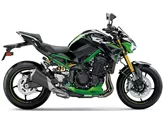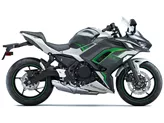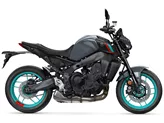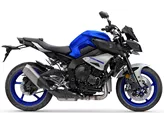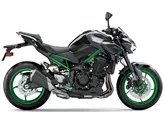Kawasaki Ninja ZX-6R 636 2013 vs. Kawasaki Z900 2019

Kawasaki Ninja ZX-6R 636 2013

Kawasaki Z900 2019
Vue d’ensemble - Kawasaki Ninja ZX-6R 636 2013 vs Kawasaki Z900 2019
The Kawasaki Ninja ZX-6R 636 2013 and the Kawasaki Z900 2019 are both impressive motorcycles, each with their own unique features and strengths.
Starting with the Kawasaki Ninja ZX-6R 636 2013, this supersport bike boasts a powerful engine with an inline configuration. It has a bore of 67 mm and a stroke of 45.1 mm, resulting in a displacement of 636 ccm. With an engine power of 131 HP and a torque of 71 Nm, this bike offers excellent performance on the road. The compression ratio is 12.9, ensuring efficient combustion. The liquid cooling system helps to regulate the engine temperature, preventing overheating.
In terms of suspension, the Ninja ZX-6R 636 is equipped with an upside-down telescopic fork in the front, which can be adjusted for compression, preload, and rebound. The rear suspension also offers the same adjustment options. The aluminum frame provides a sturdy and lightweight structure, contributing to the bike's overall agility. The braking system consists of double discs with four pistons in the front, utilizing radial, monoblock, and petal technology. Additionally, this model features traction control as an advanced rider assistance system.

Kawasaki Ninja ZX-6R 636 2013
Moving on to the Kawasaki Z900 2019, this naked bike also features an inline engine configuration. However, it has a larger bore of 73.4 mm and stroke of 56 mm, resulting in a displacement of 948 ccm. The engine power is slightly lower at 125.4 HP, but it compensates with a higher torque of 98.6 Nm. The compression ratio is 11.8, ensuring efficient combustion. Like the Ninja ZX-6R 636, the Z900 has a liquid cooling system to regulate the engine temperature.
In terms of suspension, the Z900 is equipped with an upside-down telescopic fork in the front, which can be adjusted for preload and rebound. The rear suspension also offers the same adjustment options. The frame is made of steel and has a double cradle design, providing a solid and reliable structure. The braking system consists of double discs with four pistons in the front, utilizing petal technology. As an advanced rider assistance system, the Z900 is equipped with ABS for added safety.
In terms of dimensions and weights, both bikes have the same front and rear tire widths and diameters. However, the Z900 has a longer wheelbase of 1450 mm compared to the Ninja ZX-6R 636's 1395 mm. The seat height of the Z900 is also slightly lower at 795 mm, making it more accessible for shorter riders. However, the Z900 is slightly heavier with a kerb weight of 210 kg compared to the Ninja ZX-6R 636's 194 kg.

Kawasaki Z900 2019
In terms of strengths, the Ninja ZX-6R 636 2013 offers sharpened geometry, a comfortable seating position, good handling, and uncompromising reliability. On the other hand, the Z900 2019 boasts light and natural handling with high stability, a silky engine with full pull from mid revs, high chassis transparency, and a feel-good sitting position. Additionally, the Z900 is praised for its fair price.
However, both bikes have their weaknesses. The Ninja ZX-6R 636 2013 has a high purchase price, which may deter some potential buyers. The Z900 2019, on the other hand, has a TFT display mounted too low, making it less convenient to read while riding. Additionally, the menu operation on the Z900 can be cumbersome, and the rear-view mirrors offer modest visibility.
In conclusion, both the Kawasaki Ninja ZX-6R 636 2013 and the Kawasaki Z900 2019 are impressive motorcycles with their own unique strengths and weaknesses. The Ninja ZX-6R 636 offers a powerful engine and excellent handling, while the Z900 provides a comfortable riding experience and a fair price. Ultimately, the choice between these two models will depend on the rider's preferences and priorities.
Caractéristiques techniques Kawasaki Ninja ZX-6R 636 2013 par rapport à Kawasaki Z900 2019
Avantages et inconvénients en comparaison
Avantages et inconvénients en comparaison
Kawasaki Ninja ZX-6R 636 2013

La Kawa convainc par sa bonne maniabilité et sa fiabilité sans compromis. Une moto puissante, mais certainement pas une bonne affaire.
Kawasaki Z900 2019

La nouvelle Kawasaki Z900 n'a heureusement rien perdu de son essence avec l'utilisation de l'électronique. Elle est et reste une nakedbike de classe moyenne ludique à utiliser, qui maîtrise en même temps de manière grandiose les allures rapides sur les routes de campagne. Le plaisir de conduire et l'aptitude à l'usage quotidien sont élevés, les aides à la conduite désormais intégrées offrent un plus en matière de sécurité. Vos adversaires auront désormais la vie dure.
Comparaison des prix Prix moyen du marché Kawasaki Ninja ZX-6R 636 vs Kawasaki Z900
There are a few key differences between a Kawasaki Ninja ZX-6R 636 2013 and a Kawasaki Z900 2019. It takes less time to sell a Kawasaki Z900 with 116 days compared to 122 days for the Kawasaki Ninja ZX-6R 636. Since model year 2013 1000PS.de editors have written 7 reviews for the Kawasaki Ninja ZX-6R 636 and 46 reviews for the Kawasaki Z900 since model year 2017. The first review for the Kawasaki Ninja ZX-6R 636 was published on 12/3/2012 and now has more than 20,800 views. This compares to more than 93,200 views for the first review on Kawasaki Z900 published on 11/11/2016.


